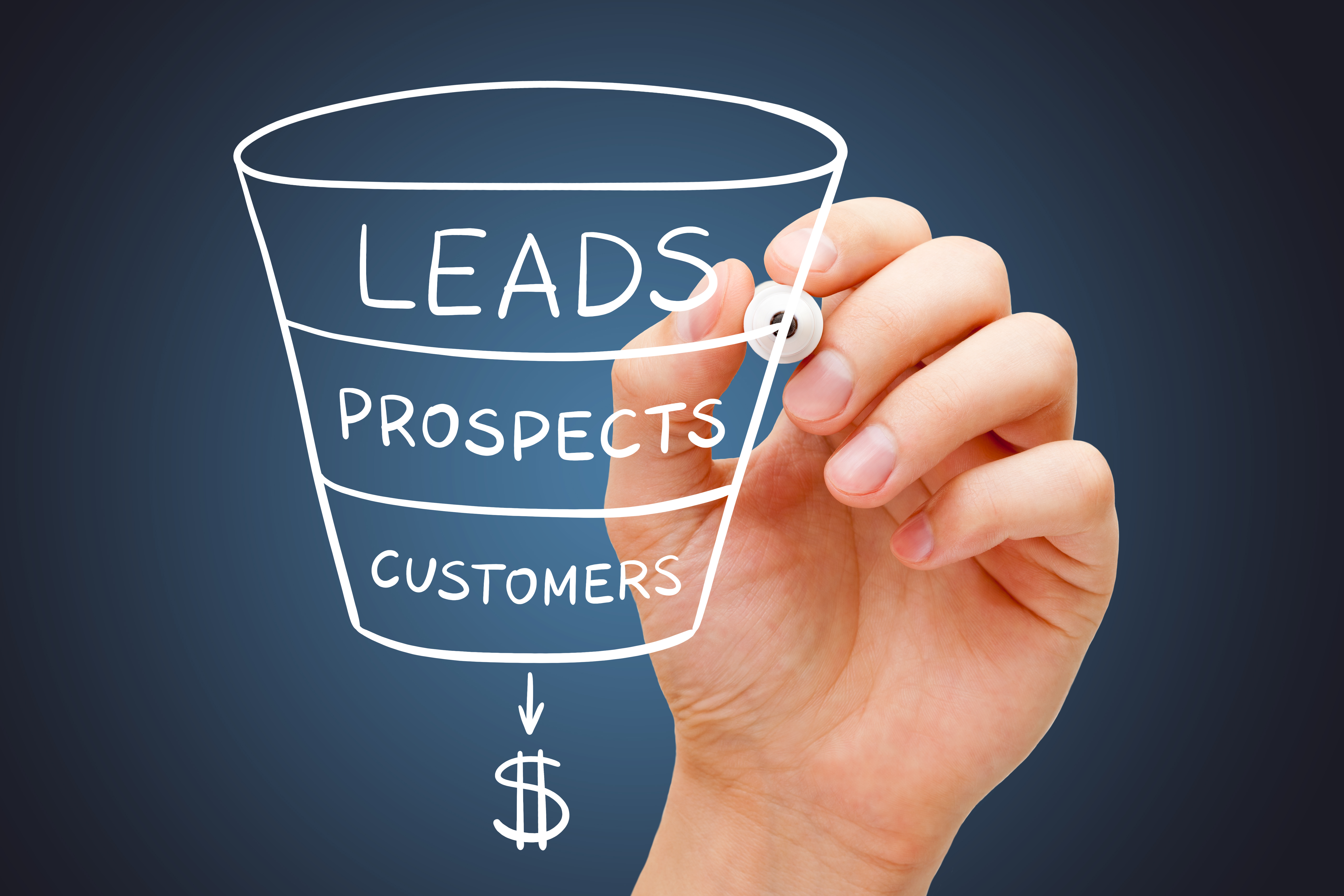If you’re in B2B, you’ve probably heard “marketing funnel” tossed around quite a bit. You might have a general idea of what it means, but do you know if your company is using this model effectively? Learn about the fundamentals to understand where your marketing efforts fall short—and how to use the funnel to boost leads and conversions.
What Is A B2B Marketing Funnel?
Imagine a funnel shape, wide at the top, narrow at the bottom. The narrow end of the funnel represents the end of a customer’s journey, the final deciding moments before they convert. The wider parts of the funnel above represent the journey that brought that customer from outside your sphere of influence all the way down to conversion.
B2B Vs. B2C Marketing Funnels
B2B and B2C funnels are modeled on similar principles, but they have some fundamental differences. For a B2B business, your potential customers are savvier and come from a much smaller, more specified pool of people. B2B decisions are also often made by multiple stakeholders rather than individuals. The way you talk to your B2B users will be different than the way other companies speak to B2C users, and the type of relationship you aim to build with your marketing funnel is a bit different, too.
B2B Marketing Vs. Sales Funnels
While sales and marketing—and their respective funnels—should be interlinked, there are some differences, mostly in perspective and approach. The sales funnel uses much of the same imagery and language as the marketing funnel, but it represents points of contact between a customer and an actual sales representative. In sales, relationship building and person-to-person interaction drive the customer down the funnel.
The marketing funnel takes a broader, less direct approach. In marketing, you must speak to potential customers through your content and brand assets. You need to appear where they are, speak to the problems they’re having, and convince them you can help without ever speaking to them directly. This is why strategic construction is key—you need to base your funnel on extensive research to have the best chance to connect with a distant audience.
Parts Of The B2B Marketing Funnel
The chief way marketers use the funnel is to break the customer journey into discrete parts. Since customers have different needs at different points in time, they need different types of content and support to satisfy their questions at each stage.
ToFu (Top Of Funnel): Awareness
Top of the funnel (or ToFu) content addresses questions from the beginning of the buyer’s journey. Customers at this stage of the funnel need something or have a problem to solve, but they’re just beginning their research. ToFu content is broader and casts a wide net to bring customers in before they’ve decided they need a solution like the one you offer.
MoFu (Middle of Funnel): Consideration
The middle of the funnel is where customers drill down into more specific questions and comparisons. Your middle of the funnel content should be more solutions-focused. Customers at this stage know what their problem is and have a general idea of the solutions available to them. They’re now trying to assess which of the available options is right for them.
In addition to more targeted blog content, whitepapers, comparison charts and product pages are often some of the most effective examples of MoFu content.
BoFu (Bottom of Funnel): Decision
At the bottom of the funnel, users are doing the final bits of research they need to make a purchase. Persuasive content that demonstrates your value over other options and explains the details of the purchase is the cornerstone of BoFu content.
Does Your B2B Funnel Need Help?
You may already have a defined B2B marketing funnel, but that doesn’t necessarily mean it’s working for you. Before we dive into what you need to do to make sure your funnel delivers for you, let’s figure out how to evaluate your existing funnel and see how you’re performing now.
How Many Leads Are You Getting?
Are you happy with the number of leads you’re getting? If the answer is no, or you’re looking to do better, you can likely address some aspects of this issue by drilling down on your marketing funnel. If you don’t have one modeled for your customers at all, it’s easy to see why you might not be attracting new customers. But maybe you’ve been using a funnel strategy and have seen some traction, but you’re not making new gains. Refining your funnel is just as important as setting one up, so whether you’ve never thought about marketing before or you’re looking to reach new depths, an expert team can help you design a strategy to pull in more leads and meet your goals.
What’s Your CPL (Cost Per Lead)?
Cost per lead (CPL) is all about the amount you spend on your marketing and sales efforts to secure one lead. If you’re spending lots of resources on marketing and not finding enough leads to justify those costs, it’s time to figure out where you can make your marketing process more efficient. The great thing about creating a marketing funnel based on evergreen content at every stage of the buyer’s journey is that you host your own content and have the ability to generate leads organically over long periods of time. While you will need to produce new content and maintain what you already have, your content marketing funnel, once it’s established, continues to work for you even when you’re spending resources elsewhere.
Are Your Leads Qualified?
Maybe you are getting leads, but they’re not converting. If this is the case, you might have a funnel in place and you might have some content strategy in place already. But if the leads those efforts generate aren’t closing, you need to assess whether your funnel is set up properly to attract the right sort of customers. You don’t want to generate leads that will never buy your product or service. So, while it is great to have a B2B marketing funnel, if it’s not set up correctly and strategically, it might be draining your resources without providing value. Consulting with an experienced marketing advisor can help you avoid fruitless spending and net you many more valuable leads.
Why An Effective Lead Funnel Matters
Getting more leads that are less expensive and better qualified might be reason enough to jump into the marketing funnel business, but there are a whole host of ancillary benefits you'll gain, too.
-
Continue selling after the sale. Content aimed at the post-sale stage can carry on your relationship with a customer even after they make a purchase, making them more likely to respond positively to upsells and subscription renewals.
-
Build awareness and trust. If you provide helpful content at every stage of the funnel, users will begin to recognize you and build a positive relationship with your brand. Plus, they’ll get a more comprehensive picture of your solution. Making it easy to find information about a potential purchase is a great way to build trust, especially for B2B transactions, which tend to be far more complex than B2C purchases.
-
Boost your SEO authority. Providing plenty of high quality content will build your site’s authority as a thought leader. Having higher authority will make it easier to rank for your target keywords as time goes on.
-
Create an efficient marketing-sales engine. Your funnel will be most successful if your marketing team has access to the insights of your sales staff. If you create a great funnel, these two teams will naturally be more aligned and better equipped to handle handoffs.
How To Build A Great B2B Marketing Funnel
There’s room to improve your funnel. Whether you’re starting from scratch or revamping old efforts, here’s what you can do to optimize your marketing strategy.
1. Set Metrics For Success
Your stakeholders will almost certainly want to know that the resources you allocate to marketing efforts are well spent, so make sure you establish your goals and set up data tracking early. Total leads and conversions are great, but if you can drill down further to track exactly which campaigns and strategies produce results, you’ll be able to iterate on your process and double down on what’s effective.
2. Know Your Audience
This is the most critical part of the process, and it’s a place where many strategies fall short. The only way your marketing funnel will be effective is if you find and meet customers where they are. That means you need to know who you’re dealing with, what they want, and where they go for guidance. Sales reps have invaluable knowledge about customer behavior, so make sure your marketing team has access to as much of that information as possible. Keyword research is essential here, but you’ll often need to dig deeper when you’re dealing with low search-volume, highly specialized industries.
3. Define Your Unique Buyer’s Journey
Defining the buyer’s journey goes hand in hand with knowing your audience, and you’ll likely perform these steps simultaneously. Since the funnel is based on a customer’s interaction with your brand over time, make sure you get enough information about the buyer to understand what they need at different stages of the process. Define this ahead of time and really dig into specifics where possible.
4. Create A Content Strategy For Every Funnel Stage
Your buyer’s journey tells you where your customer is at various stages. Your content strategy takes that information and turns it around. If your buyer begins the process of purchasing your services by researching better methods of inventory management, you need to create content that addresses that high-level need. When your customer starts digging deeper into comparisons of different solutions, make sure you have content that addresses that, too. Again, try to address your buyer’s specific needs with unique and truly helpful information to stand out from competing content creators.
5. Reevaluate And Modify
Once you’ve defined your marketing funnel and take action on a content strategy, don’t throw in the towel. Your funnel isn’t a one-and-done project. If you want to truly see leads and conversions increase, you’ll need to monitor your performance closely and make adjustments.
Take The First Step To Better Conversions
The content marketing funnel boils down to understanding who your audience is and what they need. Your internal team, particularly sales and service, has invaluable information about the customers you serve. If you have an internal marketing team, don’t silo them from the rest of your company, and make sure they’re working with your salespeople to understand customer needs.
If you don’t have a robust internal marketing department, you can always turn to the experts at an experienced B2B marketing agency like Conveyor Marketing Group. Our team knows the marketing funnel in and out. Outsourcing work like this can even be a great way to introduce an outside perspective and see how new customers might approach your brand and offerings. Not sure you’re ready to go the outsourcing route? Know the signs.
If you’re not seeing the leads and conversions you’re expecting, it’s time to evaluate how you’re drawing customers into and down your marketing funnel. Want to talk more about your company’s specific situation? Contact us and let us know how we can help.



